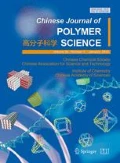Abstract
Transfer printing is a critical procedure for manufacturing stretchable electronics. During such a procedure, stamps are utilized to transfer micro devices from silicon wafers to stretchable polymeric substrates. In addition to conventional silicone rubber stamps, epoxy resin based shape memory stamps have been developed and the transfer yield is thus significantly promoted. However, elastic modulus of the epoxy stamps is too high at both glassy and rubbery states, which may break the brittle micro devices during the adhesion process under mechanical pressure. In this work, we synthesized a copolymer of butyl acrylate (BA) and polycaprolactone diacrylate (PCLDA) as a soft reversible dry adhesive enabling a shape memory capability based on crystalline transition of polycaprolactone (PCL) segments. For the sample containing 40 wt% BA and 60 wt% PCLDA, Young’s modulus was 8.3 and 0.9 MPa respectively below and above the thermal transition temperature, which was much lower than that of the epoxy adhesive. On the other hand, the soft material still provided nearly ideal shape memory fixity and recovery ratios. Subsequently, shape memory surface with cone-shaped microstructure was prepared, which enabled a heating induced strong-to-weak adhesion transition when the microstructure recovered from a pressed temporary morphology to the permanent cone-shaped morphology. Such a soft reversible dry adhesive may contribute to large-scale and automated transfer printing processing.
Similar content being viewed by others
References
Tsutsui, T.; Fujita, K. The shift from “hard” to “soft” electronics. Adv. Mater. 2002, 14(13-14), 949–952.
Kaltenbrunner, M.; Sekitani, T.; Reeder, J.; Yokota, T.; Kuribara, K.; Tokuhara, T.; Drack, M.; Schwödiauer, R.; Graz, I.; Bauer-Gogonea, S.; Bauer, S.; Someya, T. An ultralightweight design for imperceptible plastic electronics. Nature 2013, 499(7459), 458–463.
Kim, D. H.; Xiao, J.; Song, J.; Huang, Y.; Rogers, J. A. Stretchable, curvilinear electronics based on inorganic materials. Adv. Mater. 2010, 22(19), 2108–2124.
Kim, D. H.; Rogers, J. A. Stretchable electronics: materials strategies and devices. Adv. Mater. 2008, 20(24), 4887–4892.
Rogers, J. A.; Someya, T.; Huang, Y. Materials and mechanics for stretchable electronics. Science 2010, 327(5973), 1603–1607.
Carlson, A.; Bowen, A. M.; Huang, Y.; Nuzzo, R. G.; Rogers, J. A. Transfer printing techniques for materials assembly and micro/nanodevice fabrication. Adv. Mater. 2012, 24(39), 5284–5318.
Yang, H.; Zhao, D.; Chuwongin, S.; Seo, J. H.; Yang, W.; Shuai, Y.; Berggren, J.; Hammar, M.; Ma, Z.; Zhou, W. Transfer-printed stacked nanomembrane lasers on silicon. Nat. Photon. 2012, 6(9), 615–620.
Meitl, M. A.; Zhu, Z.; Kumar, V.; Lee, K. J.; Feng, X.; Huang, Y.; Adesida, I.; Nuzzo, G. R.; Rogers, J. A. Transfer printing by kinetic control of adhesion to an elastomeric stamp. Nat. Mater. 2006, 5(1), 33–38.
Xie, T.; Xiao, X. Self-peeling reversible dry adhesive system. Chem. Mater. 2008, 20(9), 2866–2868.
Wang, R.; Xiao, X.; Xie, T. Viscoelastic behavior and force nature of thermo-reversible epoxy dry adhesives. Macromol. Rapid Commun. 2010, 31(3), 295–299.
Xu, H.; Yu, C.; Wang, S.; Malyarchuk, V.; Xie, T.; Rogers, J. A. Deformable, programmable, and shapememorizing micro optics. Adv. Funct. Mater. 2013, 23(26), 3299–3306.
Huang, Y.; Zheng, N.; Cheng, Z.; Chen, Y.; Lu, B.; Xie, T.; Feng, X. Direct laser writing-based programmable transfer printing via bioinspired shape memory reversible adhesive. ACS Appl. Mater. Interfaces 2016, 8(51), 35628–35633.
Zhao, Q.; Qi, H. J.; Xie, T. Recent progress in shape memory polymer: new behavior, enabling materials, and mechanistic understanding. Prog. Polym. Sci. 2015, 49–50, 79–120.
Leng, J.; Lan, X.; Liu, Y.; Du, S. Shape-memory polymers and their composites: stimulus methods and applications. Prog. Mater. Sci. 2011, 56(7), 1077–1135.
Gu, S. Y.; Gao, X. F.; Jin, S. P.; Liu, Y. L. Biodegradable shape memory polyurethanes with controllable trigger temperature. Chinese J. Polym. Sci. 2016, 34(6), 720–729.
Liao, J. X.; Huang, J. H.; Wang, T., Sun; W. X.; Tong, Z. Rapid shape memory and pH-modulated spontaneous actuation of dopamine containing hydrogels. Chinese J. Polym. Sci. 2017, 35(10), 1297–1306.
Eisenhaure, J. D.; Xie, T.; Varghese, S.; Kim, S. Microstructured shape memory polymer surfaces with reversible dry adhesion. ACS Appl. Mater. Interfaces 2013, 5(16), 7714–7717.
Xie, T.; Rousseau, I. A. Facile tailoring of thermal transition temperatures of epoxy shape memory polymers. Polymer 2009, 50, 1852–1856.
Zheng, N.; Fang, G.; Cao, Z.; Zhao, Q.; Xie, T. High strain epoxy shape memory polymer. Polym. Chem. 2015, 6, 3046–3053.
Zhao, R.; Zhao, T.; Jiang, X.; Liu, X.; Shi, D.; Liu, C.; Yang, S.; Chen, E. Thermoplastic high strain multishape memory polymer: side-chain polynorbornene with columnar liquid crystalline phase. Adv. Mater. 2017, 29(12), 1605908.
Zhang, G.; Zhao, Q.; Zou, W.; Luo, Y.; Xie, T. Unusual aspects of supramolecular networks: plasticity to elasticity, ultrasoft shape memory, and dynamic mechanical properties. Adv. Funct. Mater. 2016, 26(6), 931–937.
Lendlein, A.; Schmidt, A. M.; Langer, R. AB-polymer networks based on oligo (ε-caprolactone) segments showing shape-memory properties. Proc. Natl. Acad. Sci. 2001, 98(3), 842–847.
Saatchi, M.; Behl, M.; Nöchel, U.; Lendlein, A. Copolymer networks from oligo (ε-caprolactone) and nbutyl acrylate enable a reversible bidirectional shapememory effect at human body temperature. Macromol. Rapid Commun. 2015, 36(10), 880–884.
Kweon, H.; Yoo, M. K.; Park, I. K.; Kim, T. H.; Lee, H. C.; Lee, H. S.; Oh, J. S.; Akaike, T.; Cho, C. S. A novel degradable polycaprolactone networks for tissue engineering. Biomaterials 2003, 24(5), 801–808.
Acknowledgments
This work was financially supported by the National Natural Science Foundation of China (Nos. 21504077 and 51673169), Natural Science Foundation of Zhejiang Province for Distinguished Young Scholar (No. LR18E030001), and National Key Basic Research Program of China (No. 2015CB351903).
Author information
Authors and Affiliations
Corresponding author
Electronic supplementary material
Rights and permissions
About this article
Cite this article
Dong, JT., Zou, WK., Chen, F. et al. A Soft Shape Memory Reversible Dry Adhesive. Chin J Polym Sci 36, 953–959 (2018). https://doi.org/10.1007/s10118-018-2119-6
Received:
Accepted:
Published:
Issue Date:
DOI: https://doi.org/10.1007/s10118-018-2119-6




